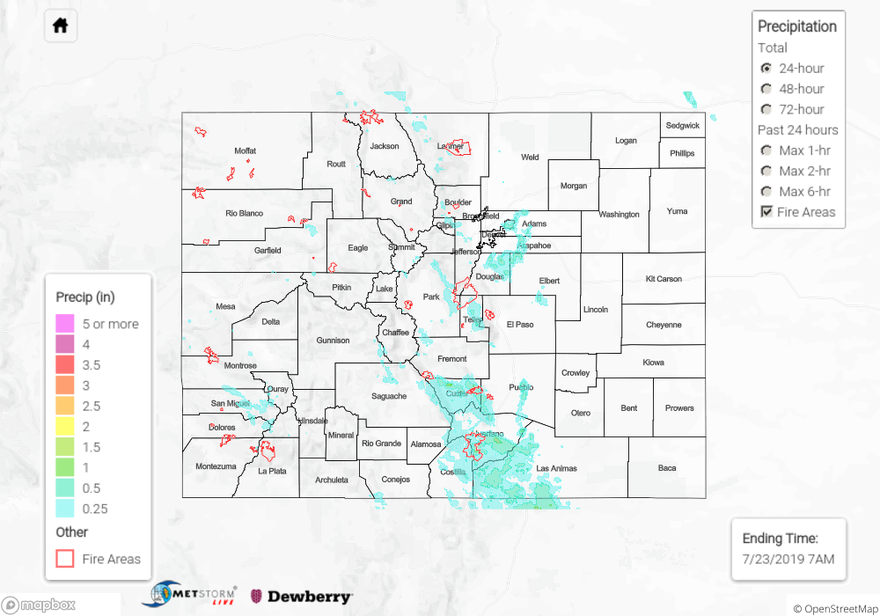Issue Date: Tuesday, July 23rd, 2019
Issue Time: 9:50AM MDT
Summary:
The heavy rainfall threat moved south on Monday into the Southeast Mountains and Raton Ridge area. Moisture continue to stream in around the high and afternoon upslope flow kicked off thunderstorm activity around 1PM MDT over western CO. Best moisture was over the San Juan Mountains as the southern position of the high allowed a little more moisture to meander northwards. Rain totals over the area were estimated around 0.25 inches with a CoCoRaHS station 7 miles north of Durango reporting 0.17 inches. High bases on weak thunderstorms allowed for some gusty winds as well. There were 50-65 mph winds recorded over Garfield, Pitkin and Montrose Counties.
Storms initiated a couple hours later over the eastern mountains. Movement to the southeast was a bit quicker than the last couple of days, so not quite as high of accumulations. Storms moved into the adjacent plains in the late afternoon/early evening with a large cluster of storms outside the Denver Metro area. This weak bow echo produced between 0.8 to 1 inch of rainfall with 1 inch hail and an 80 mph gust (measured at DIA). Non-hail contaminated ALERT gages recorded between 0.2 and 0.75 inches with these storms.
There were several reports of flooding over Huerfano, Custer and Costilla Counties with Flash Flood Warnings and Advisories to go with them. There were several road closures due to the flooding and rock/mud slides. South Abeyta Creek overflowed its banks by 2 feet and Middle Creek flooded as well. There was possible damage to railroad tracks 3 miles WNW of La Veta from the flooding. A lot of these reports, not surprisingly, were over the recent burn areas (Junkins and Spring Creek). The Hayden Pass burn area likely helped contribute to the high runoff in the area. Totals over the Junkins burn area were estimated just under 1 inch, and 0.75 inches in an hour is known to cause flooding issues. Over the Spring Creek burn area, 1 inch was estimated. We have been using 0.4 inches in an hour as our threshold this season, so again, not surprised by these reports. A funnel was reported near Westcliffe, CO. The Custer County sheriff’s office reported power lines down and a possible propane leak from this tornado. This will likely be evaluated by the NWS sometime in the next couple of days. Thankfully, there were no reports of injuries from yesterday (as of this morning). Lastly, the eastern facing slopes of the Southeast Mountains (facing San Luis Valley) got in on the rainfall action, too. The Great Sand Dunes CoCoRaHS stations reported between 0.75 and 0.95 inches. That’s a large chunk of their expected June rainfall. All storms yesterday ended around 11:30PM MDT as they crossed into New Mexico.
To see estimated precipitation totals over your neighborhood on Monday, scroll down the State Precipitation Map below.
Click Here For Map Overview
